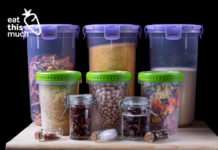(Reposted from my reddit account)
There’s nothing more motivating than seeing the scale move in the right direction, but it rarely tells the whole story of how your body is reacting. Using a measuring tape is an easy way to measure things that the scale and the mirror disagree about. Here’s a primer on the how and why of various methods.
Potential Issues with scale weight alone:
Glycogen and ‘water weight’
- Most people have between 4-10lbs that comes off very rapidly (on the order of hours to days1) and is very easy to regain. Sit in a sauna for 2 hours and you’ll be lighter – but only until you drink some water.
- Glycogen is the storage form of glucose, and (for the sake of simplicity) water loves following it around. When you exercise glycogen is broken down causing some water to leave the muscle. If you’re sweating heavily some of that water is lost making the whole system lighter. Just like in our sauna example, drinking water and consuming carbohydrates refuels the muscle and returns you to a normal weight. A similar process also happens during the night, causing most people to lose a pound or two ‘in their sleep’ which is regained at breakfast.
- Avoid confusion by weighing yourself at the same time of day, and take caution if you are doing any type of low carb, keto, or carb-cycling sort of plan. During low carb phases muscle glycogen is not replenished the same way and this over emphasizes weight loss at first, then causes rapid weight gain on the refeed.
- If you are new to exercising, it is totally normal to gain a few lbs at the beginning (or not see your weight start to drop) as your muscles increase the amount of glycogen (and therefore water) that they pick up after training.
Scale Factors
- Most scales are fairly accurate these days, even the cheap ones, so you should be fine as long as you are consistent with the scale you use. If you have an older type bathroom scale with a needle that points to the weight, make sure to read it from the same angle every time – leaning forward or backwards can shift the needle on some of them.
- Just like at the doctor’s office you should take off your shoes before weighing yourself for accuracy, but it’s also okay to just wear the same pair of shoes every time if you prefer.
Fat and Muscle changing at once
- Since fat and muscle are made of different materials and have different purposes they look very different.
- This classic picture shows you an equivalent weight of fat and muscle to showcase how different their density is.
- The best transformations come from maintaining or building muscle in addition to losing fat, which is something the scale won’t be able to show.
The Solution? Measuring Tape
A few measurements with the tape can help settle any concerns you have, and ultimately changes in the tape measurements are going to be a better measure of how you look than changes in your body weight.

Key measurements
1. Waist Circumference: For your Health
This is becoming a really hot topic due to research that shows abdominal (really visceral) fat accounts for most of the danger of excess body weight2. Run your fingers up your hipbones to the highest point (the iliac crest) and then measure around your waist slightly above that point. The ‘risk of disease’ cutoff is 37in for me and 32in for women, although people with bigger frames can probably get away with a little bit more.
2. Upper arm and thigh: For your Gainz
These two are usually the easiest to measure, and are the things people will probably be most able to notice with your clothes on. A neat little trick to estimate changes in body fat is to take measurements both relaxed and flexed. If there were no fat on the limb the flexed measure would be bigger, if there were no muscle then it would not change. As the two numbers move further apart you can be pretty certain you are getting leaner, which is a lot more objective than just looking in the mirror or asking people to take their best guess.
Measure the upper arm with the elbow at 90 degrees, the ‘make a muscle’ pose, and measure the thighs about 2/3 of the way up your leg, where it is the thickest. This is usually easier to do with the knee straight, but just be consistent if you change it up.
Alternatives
Bioimpedance scales for checking BF%
- Just about every scale wants to tell you about your bodyfat % these days but it is important to consider how this number is being generated. If the scale doesn’t care whether you are wearing shoes or not, it is probably just running your height/weight/age through a formula to figure out an average. This number is probably not useful to you at all.
- A true bioimpedance scale (in theory) sends an electrical current through your body, and determines the amount of fat based on your electrical resistance.
- Unfortunately their measurements have an error rate around +/- 10% for a variety of reasons. If the scale only runs a current through your feet, the current takes the shortest path possible and does not contain any information about the upper body. Even with a scale that uses both hand and food bioimpedance, hydration and bodyfat distribution can cause some errors in measurement.
- Takeaway – use bodyfat % only in comparison to yourself on the same scale, the error rates between people make this method too inaccurate to rely on. If you already have a scale that does this, take the information with a grain of salt.
Bodyfat calipers for BF%
- These guys are pretty neat, although finding someone who knows how to use them effectively is probably the biggest hurdle these days. This is the scientific form of your mom pinching your stomach and calling you fat.
- Calipers measure the thickness of ‘pinched skin’ and then those values are converted to bodyfat % with a chart. These guys have surprisingly high accuracy, but it falls off for people above 35% bodyfat or below 15% and the lack of easy boney landmarks means there will have to be a judgement call on the part of the tester.
- The most common is a 3 site test, you can get an idea of how it will go by pinching the skin on the back or your tricep, just below your belly button, and on top of your thigh. Note the similarity to the measuring tape sites…
Water displacement tests, Bod Pods, MRIs
- If you really really just HAVE to know what your bodyfat% is these are the ones that scientists use for their studies.
- Private clinics for weightloss, big hospitals, and research universities are the most likely places to have one because they have up to 6 figure pricetags for the newer DXA machines. A displacement test is usually done in water but I think the bodpod uses air somehow.
- The general idea is that the muscle is a little bit more dense than water and fat is a little bit less dense. By weighing a person, then weighing them again underwater (or inside the bodpod) you get a general idea of how dense a person by how much they “float”. These are plenty accurate, but there’s a couple assumptions in there that cause error. The biggest one is that you have to exhale before being weighed, but people are pretty variable in the amount of air that is left inside when they exhale.
MRIs
- What hospitals use and they are vastly too expensive for their own good. These guys can show you a slice of your body, and are probably overkill unless you want to check yourself for fatty liver disease.
DXA/DEXA
- What my old lab used to use, these guys scan you with radiation (once again using density to make their calculations) and produce not only a measurement but a picture of your body with the regions of fat separated.
- This one might be worth springing for if you’ve got the disposable income, some models can measure fat around the organs and other specialty measures like bone density which is a good thing to be keeping tabs on anyway.
References
1: http://ajcn.nutrition.org/content/56/1/292S.full.pdf
2:http://www.ncbi.nlm.nih.gov/pubmed/21545944
This article was written by Michael Chronley, CSCS, Fitness & Nutrition Advisor.









